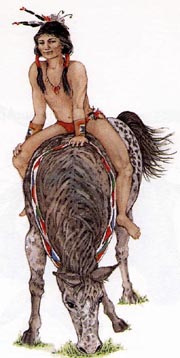

|
By the early 18th century, most Shawnee lived in the Ohio
Valley area. Their population had been reduced through disease
and warfare to approximately 3,000 people, but despite the
contact with Europeans, the reduction in population, and the
shift to a more settled existence, traditional Shawnee life and
culture was very much in evidence.
"When dew is on the grass in the morning, it will not rain during the day; when it is not there after darkness has fallen, it will rain before morning. When birds fly low and silently, a bad storm is coming, and when the pigeon sits close to the trunk of the sapling during daytime, a great wind will soon blow. When the leaves of the maples turn over to show their underside, thunder and lightning will soon come. If the blackbirds flock together and start to fly south when summer is still with us, there will be much snow during the winter. When the swamp muskrat builds a low house of reeds and mud, the winter will be mild, but the larger and higher the house he builds, the worse the winter will be; and when he builds no house at all, but instead burrows beneath the ground, prepare for severe cold, for the waters of swamps and ponds and smaller streams will freeze to the bottom and even the great Spaylaywitheepi (Ohio River) will freeze so that a horse may walk upon it." Perhaps the most important thing that happened to an individual in Shawnee society - indeed, the thing that made a newborn considered an actual human being - was the naming ceremony, arranged by the parents shortly after a Shawnee child was born. During the naming ceremony (which continues to this day), two people - not necessarily relatives - chosen by the parents to name the child prayed for a name. When the name appeared in a dream or came as a thought, the name givers determined which name group the name belonged to (name groups were nonfamilial associations of people linked by their names). On the 10th morning after the birth of the child, the mother - who had been held in seclusion - emerged, and a special ceremony was held to name the child. The name givers told the parents the names they had selected for the child, being sure to offer two names from different name groups so the parents would have some control over the child's affiliation. If the parents disagreed on the name, > the mother made the final decision. The father gave a name giver a string of white beads, which were eventually tied around the baby's neck and worn until the string broke. Everyone had a breakfast prepared by the female relatives of the child, during which a taste of all the foods was put on the baby's tongue. If a child turned out to be sickly, a name changing ceremony would follow. A name-changing ceremony was also organized if the name givers had mistakenly given the infant a name that someone else already had, because of the belief that sharing a name was quite dangerous- if one person died, there was a good chance that their namesake would also die. The Shawnees trained their children early on in a strong moral code that existed within the tribe, teaching them to be supportive of and absolutely honest toward tribe members. Children were rarely threatened or physically punished, and using a stick to beat a child was considered a disgrace both for the child and for the parent. Punishment and threats were never used to make children obey. Instead, parents and other adults appealed to the child's pride, and a few words of praise from an adult was considered the highest prize for good behavior. A parent would punish a child by shaming him, telling a visitor the child's faults in front of the child. A parent who wanted to have an errand run or a chore taken care of only needed to say, in the presence of his children, what it was he wished and often with the comment added, "I wonder if there is a good child anywhere around who could do this." Normally there would then be a scramble among the children as they vied to fulfill the wish of mother or father. Praise from a parent or neighbor was a cherished reward and there was always community support in supplying such praise. It was not uncommon for anyone witnessing a child performing a task to wonder aloud "whose good child is this who does such a thing so nicely?" and, if told who the parent was, to exclaim, "My! Has so-and-so got such a good child as this?" In cases where a child did something bad, it was probably never done again, simply by the parent saying something like "Oh, how sad I am that my child has done such a bad thing. I truly hope he will never do it again."
 
© 1997 shawnee_1@yahoo.com
< |